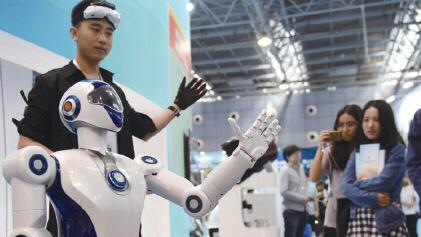Manufacturing is the cornerstone of China’s economy and will remain so into the future. Upgrading the manufacturing-focused real economy through innovation and supply-side reform is at the top of the country’s development agenda. China’s leaders hope this “new dynamic”–a catch-all term representing new sectors, new businesses, new commerce models and new products – will serve as a force for growth.
The integration of innovation and industrial development underpins this “new dynamic.” Too strong an emphasis on either innovation, or on industry, will risk derailing economic growth and reform.
A crossroads is approaching. This new dynamic currently generates about 12 percent of China’s economy, and has yet to climb to 30 percent – a threshold for stable expansion–or higher to become the main engine of the economy. There is currently a tug-of-war between the “new dynamic” and the old one, which relies on large inputs of labor and capital.
China’s economy is vulnerable to risks which have built up in the past, and will resurface. Uncertainties still grip the world economy. Interest groups will persist in their attempts to hinder domestic reforms. The budding new dynamic will have to stare down all the potential shocks that these challenges may create.
The success of change will depend on whether all this knotted mess, including the balance between the market and government, between the real and virtual economies, and between isolated and systematic financial risks, can be untangled. The will to reform is also crucial. Governments at all levels, especially local ones, must push the new dynamic to grow to 30 to 50 percent of their economy, at which point it will be steady and strong enough to grow sustainably on its own.
Integrating innovation and industry is a perfect solution to these economic dilemmas, and will play a decisive role in boosting China’s long-term growth. Specifically, it will reshape China’s economy in six main ways.
First, it will greatly affect China’s growth potential. The speed and structure of growth potential typically resonate with the economic and social landscape. Integrating innovation and industry will trigger industrial advances and replace the old engine of growth with a new model. This will lay out the future trajectory of China’s growth potential.
Second, how much the new dynamic will replace the old one will be governed by the success of this integration. It is true that the current growth of China’s economy, which has been so far stable, is in part due to a better-than-expected rebound of external demand, as well as the recovery of the steel and coal sectors driven by policies to reduce overcapacity. However, it is also true that new sectors, new businesses, new models and new products have contributed a great deal to support this growth. When the Internet joined hands with the bricks-and-mortar sectors, the sharing economy grew to around US$524 billion in 2016, soaring 103 percent from that of 2015. Some even predicted that the sharing economy would be crucial to prevent China’s economy from lagging.
Third, a better structured and more efficient investment pattern is rarely achieved without rapidly integrating innovation and industry. Investment will likely remain the most important driving force for China’s economy. The fundamental question is how the decline in investment in real estate and infrastructure construction will be filled by investment opportunities in innovation and industrial integration. This will set the future parameters of investment in China which will impact the speed and scale of the new engine of growth.
Fourth, the integration will balance investment and consumption, which has always been difficult. Wage increases must come from, and keep pace with, increasing productivity. Investment that improves productivity creates more high-skilled and well-paid jobs. These two factors – investment and wages – reinforce each other to grow Chinese consumer demand and the nation’s middle class who want higher quality goods.
Fifth, effective integration will allow China to become a world-leading manufacturing power, laying the foundation for a new round of strong growth. By implementing supply-side reform and the Made in China 2025 roadmap, China is trying to remove barriers to innovation and manufacturing. China’s international manufacturing competitiveness, particularly in traditional manufacturing, will grow through the integration of innovation and industry. Accordingly, the Chinese economy will move up in the world to the mid-to-high-end from its current position at the mid-to-low-end.
Sixth, integration is a fundamental solution to the lingering problem of too much money sloshing around the so-called virtual economy, including in real estate and finance, which attracts speculation. When investment can be put to work integrating innovation and industry, potential financial risks will melt away. Indeed, there is a huge demand for investment to finance the growth of the new dynamic. Only when the financial resources serve this purpose will the misuse of the money supply be contained.

 Old Version
Old Version